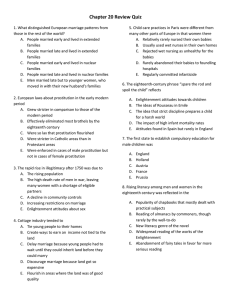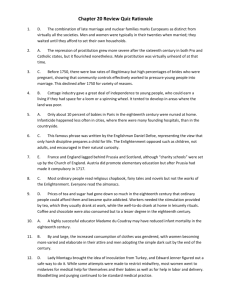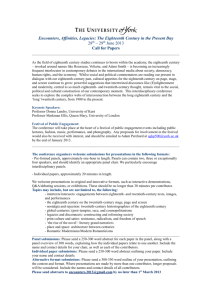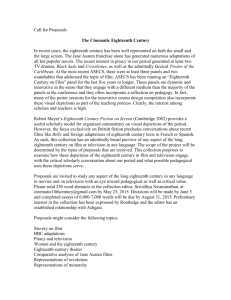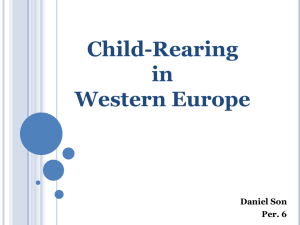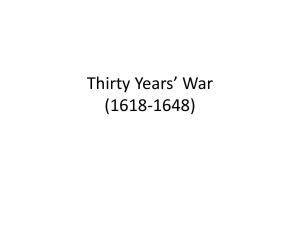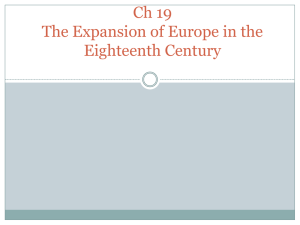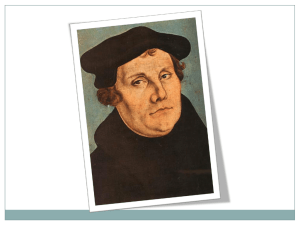Chapter 19 Outline
advertisement
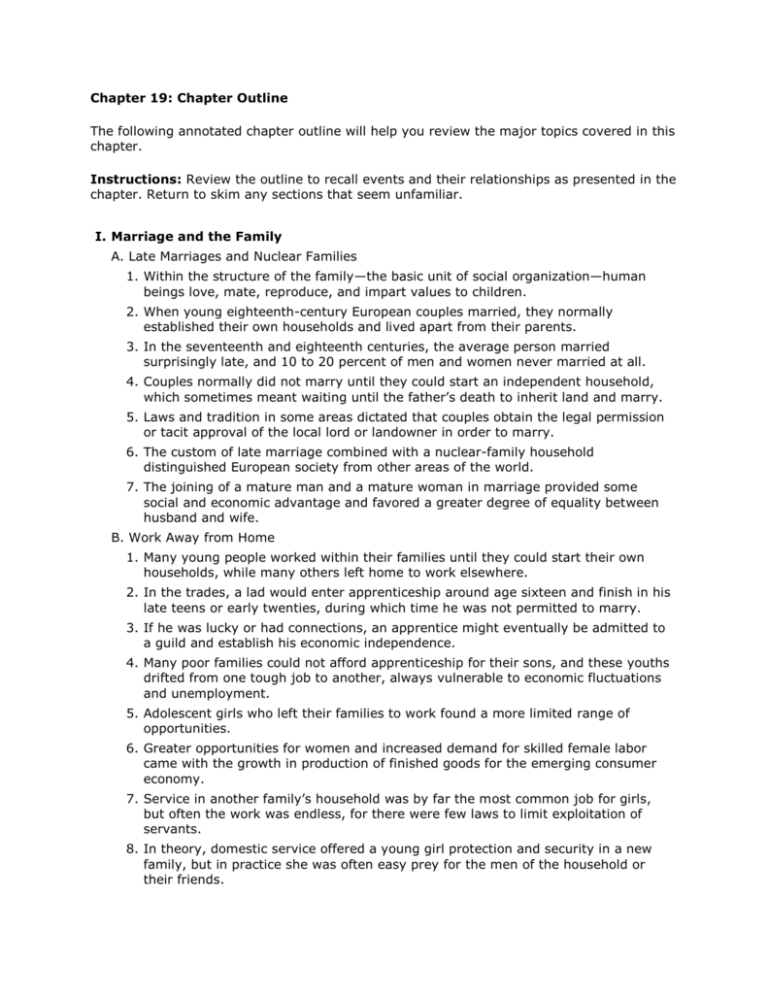
Chapter 19: Chapter Outline The following annotated chapter outline will help you review the major topics covered in this chapter. Instructions: Review the outline to recall events and their relationships as presented in the chapter. Return to skim any sections that seem unfamiliar. I. Marriage and the Family A. Late Marriages and Nuclear Families 1. Within the structure of the family—the basic unit of social organization—human beings love, mate, reproduce, and impart values to children. 2. When young eighteenth-century European couples married, they normally established their own households and lived apart from their parents. 3. In the seventeenth and eighteenth centuries, the average person married surprisingly late, and 10 to 20 percent of men and women never married at all. 4. Couples normally did not marry until they could start an independent household, which sometimes meant waiting until the father’s death to inherit land and marry. 5. Laws and tradition in some areas dictated that couples obtain the legal permission or tacit approval of the local lord or landowner in order to marry. 6. The custom of late marriage combined with a nuclear-family household distinguished European society from other areas of the world. 7. The joining of a mature man and a mature woman in marriage provided some social and economic advantage and favored a greater degree of equality between husband and wife. B. Work Away from Home 1. Many young people worked within their families until they could start their own households, while many others left home to work elsewhere. 2. In the trades, a lad would enter apprenticeship around age sixteen and finish in his late teens or early twenties, during which time he was not permitted to marry. 3. If he was lucky or had connections, an apprentice might eventually be admitted to a guild and establish his economic independence. 4. Many poor families could not afford apprenticeship for their sons, and these youths drifted from one tough job to another, always vulnerable to economic fluctuations and unemployment. 5. Adolescent girls who left their families to work found a more limited range of opportunities. 6. Greater opportunities for women and increased demand for skilled female labor came with the growth in production of finished goods for the emerging consumer economy. 7. Service in another family’s household was by far the most common job for girls, but often the work was endless, for there were few laws to limit exploitation of servants. 8. In theory, domestic service offered a young girl protection and security in a new family, but in practice she was often easy prey for the men of the household or their friends. 9. Servant girls who ended up pregnant were often thrown out in disgrace and turned to prostitution as a matter of survival. C. Premarital Sex and Community Controls 1. Although not unknown, birth control in Europe before the nineteenth century was primitive and quite undependable. 2. Condoms, made from sheep intestines, were expensive and mainly used by aristocratic libertines and prostitutes. 3. The most common method of contraception was coitus interruptus—withdrawal by the male before ejaculation. 4. Despite the combination of sexual activity and lack of reliable contraception, illegitimate babies were apparently a rarity, at least as far as the official church records are concerned. 5. A study of parish records in seventeenth-century England shows that 20 percent of children were conceived before the couple was married, while only 2 percent were born out of wedlock; these statistics reflect the powerful community controls of the traditional village. 6. The community’s effort to police personal behavior and maintain moral standards was a significant part of village life, and violators—spouse abusers or adulterers, for instance—were subject to degrading public rituals such as humiliating donkey rides, rotten vegetables splattered on their doorsteps, and insulting midnight serenades. D. New Patterns of Marriage and Illegitimacy 1. Long-standing patterns of marriage and illegitimacy shifted dramatically in the second half of the eighteenth century; for example, young people increasingly chose partners for themselves rather than following the economic or social interests of their families. 2. As more youths worked for their own wages, their economic autonomy translated into increased freedom of action. 3. Migration to the cities increased, and the urban life provided young people with more social contacts and less social control. 4. A rise in sexual activity among young people caused the percentage of illegitimate births to skyrocket to as much as 36 percent of all births in some communities by the middle of the nineteenth century. 5. As in previous generations, many of the young couples who engaged in sexual activity intended to marry, but fewer men followed through on their promises once the young women became pregnant. 6. Many soldiers, day laborers, and male servants were no doubt sincere in their proposals, but their insecure economic situation made them hesitant to take on the burden of a wife and child. 7. Old patterns of marriage and family broke down as romantic aspirations of young people were frustrated by low wages, inequality, and changing economic and social conditions. E. Sex on the Margins of Society 1. Prostitution, which offered both single and married men an outlet for sexual urges, encountered increasingly harsh and repressive laws in the sixteenth and early seventeenth centuries. 2. Most prostitutes were working women who turned to the sex trade when confronted with unemployment or seasonal shortages of work. 3. Imprisonment, banishment, and venereal disease were constant threats for prostitutes. 4. Relations between individuals of the same sex attracted even more condemnation than prostitution and were prohibited by law in most European states, under pain of death. 5. Protected by their status, nobles and royals such as King James I sometimes openly indulged their same-sex passions, which were accepted as long as they married and produced legitimate heirs. 6. In the late seventeenth century new homosexual subcultures began to emerge in Paris, Amsterdam, and London, with their own slang, meeting places, and styles of dress and a belief that their same-sex desire made them fundamentally different from other men. 7. Same-sex relations existed among women as well, but they attracted less anxiety and condemnation than those among men. 8. Across the early modern period, traditional tolerance for sexual activities outside of heterosexual marriage began to fade, and attacks on immorality increased. II. Children and Education A. Child Care and Nursing 1. Newborns were vulnerable to infectious diseases and to dehydration brought on by bouts of ordinary diarrhea. 2. Of those who survived infancy, many more died in childhood. 3. Women who bore six children faced a 5 to 10 percent cumulative risk of dying in childbirth due to blood loss, shock, and postnatal infections. 4. The joy of pregnancy was thus shadowed by fear of loss of the mother or her child. 5. Women of the lower classes generally breast-fed their infants for two years or more, which limited the mothers’ fertility and provided infants with precious immunity-producing substances. 6. Instead of nursing their own children, women of the aristocracy and upper middle class typically hired a live-in wet nurse. 7. Working women in the cities also relied on wet nurses because they needed to earn a living. 8. Rural wet-nursing was a widespread business in the eighteenth century, conducted within the framework of the putting-out system, in which children would actually live with the wet nurse until weaned. 9. Reliance on wet nurses contributed to high levels of infant mortality due to the dangers of travel, the lack of supervision of conditions in wet nurses’ homes, and the need to share milk between a wet nurse’s own baby and the baby or babies she was hired to feed. 10. Wet-nursing was particularly common in northern France, whereas maternal nursing was more common in other parts of Europe. 11. Sending babies to a wet nurse was likely more common in France because of a combination of cultural, socioeconomic, and biological factors. 12. Not only was wet-nursing a centuries-old tradition in France, but few alternatives to breast milk existed. 13. In the second half of the eighteenth century critics blamed a perceived decline in population on women’s failure to nurture their children properly. B. Foundlings and Infanticide 1. The young woman who could not provide for an unwanted child had few choices: abortions were illegal and dangerous, so some hid their pregnancies, delivered in secret, and then smothered their newborn infants. 2. Infanticide was punishable by death if discovered. 3. Foundling homes (orphanages) first took hold in Italy and then spread to the rest of Europe. 4. As new foundling homes were established and old ones expanded, the number of foundlings being cared for surged; by the end of the eighteenth century European foundling hospitals were admitting around one hundred thousand abandoned children each year. 5. By the 1770s one-third of all babies born in Paris were being immediately abandoned to foundling homes by their mothers, and one-third of those came from married couples who were too poor to feed another child. 6. Sadly, even in the best foundling homes, 50 percent of the babies normally died within a year, and in the worst homes the rate was closer to 90 percent. 7. So great were the losses that some contemporaries called the foundling hospitals “legalized infanticide.” C. Attitudes Toward Children 1. Some scholars have claimed that parents did not risk forming emotional attachments to young children because of high mortality rates. 2. Such emotional prudence could lead to emotional distance, even to outright neglect. 3. Evidence from diaries, letters, and family portraits indicates that many parents did cherish their children and suffered greatly when they died. 4. In a society characterized by much violence and brutality, discipline of children was often severe. 5. The Enlightenment, however, produced an enthusiastic new discourse about childhood and child rearing. 6. Starting around 1760 critics called for greater tenderness toward children and proposed imaginative new teaching methods. 7. For Enlightenment thinkers, the best hopes for creating a new society, untrammeled by the prejudices of the past, lay in a radical reform of child-rearing techniques. 8. Jean-Jacques Rousseau’s Emile, or On Education (1762) fervently advocated breast-feeding and natural dress for all children, along with plenty of fresh air and exercise for boys. 9. Rousseau, believing that women’s “nature” destined them for a life of marriage and child rearing, insisted that girls’ education focus on their future domestic responsibilities. 10. For all his influence in the area of child-rearing techniques, Rousseau also reveals the occasional hypocrisy of Enlightenment thinkers: he abandoned all five of his children to foundling hospitals. D. The Spread of Elementary Schools 1. Schools charged specifically with educating children of the common people began to appear in the second half of the seventeenth century. 2. Such schools specialized in teaching six- to twelve-year-old children basic literacy, religion, and perhaps some arithmetic for the boys and needlework for the girls. 3. Believing that the path to salvation lay in careful study of the Scriptures, Scottish Presbyterians established an effective network of parish schools for rich and poor alike. 4. The Church of England established “charity schools” to instruct poor children. 5. Inspired by the Protestant idea that every believer should be able to read the Bible and by the new idea of a population capable of effectively serving the state, Prussia made attendance at elementary schools compulsory for boys and girls. 6. In the 1660s Catholic France began setting up charity schools to teach poor children their catechism and prayers as well as reading and writing. 7. In 1774 the Habsburg ruler Maria Theresa issued her own compulsory education edict, imposing five hours of school, five days a week, for all children aged six to twelve. 8. Across Europe some elementary education was becoming a reality, and schools were of growing significance in the life of the child. III. Popular Culture and Consumerism A. Popular Literature 1. The surge in childhood education in the eighteenth century led to a remarkable growth in basic literacy between 1600 and 1800. 2. The growth in literacy promoted growth in reading, both of the Bible and of short pamphlets known as chapbooks that featured Bible stories, prayers, devotions, and the lives of saints and exemplary Christians. 3. Entertaining, often humorous stories formed a second element of popular literature that included fairy tales, medieval romances, true crime stories, and fantastic adventures; such tales often contained nuggets of ancient folk wisdom, counseling prudence in a world full of danger and injustice. 4. Some popular literature was highly practical, dealing with rural crafts, household repairs, useful plants, and similar matters. 5. Much lore was stored in almanacs, where calendars listing secular, religious, and astrological events were mixed with agricultural schedules, arcane facts, and jokes. 6. Although most ordinary people did not read the great works of the Enlightenment, urban working people were exposed to new ideas through various means, including cheap pamphlets and the rumors and gossip that spread through workshops, taverns, and cafés. 7. Thomas Paine, an ordinary Englishman who emigrated to the colonies, authored the 1776 pamphlet Common Sense, an attack on the weight of custom and the evils of government against the natural society of men. 8. Paine’s pamphlet sold 120,000 copies in its first months of publication, a testament to working people’s ability to receive Enlightenment ideas. B. Leisure and Recreation 1. Despite the spread of literacy, the culture of the village remained largely oral rather than written. 2. Socializing, an important activity in any village, took the form of peasant families talking and singing and doing craftwork around the fireplace, women gathering to sew and chat, and men drinking and talking in the village tavern. 3. Towns and cities offered a wider range of amusements, including pleasure gardens, theaters, and lending libraries. 4. Leisure activities were another form of consumption marked by growing commercialization. 5. This period saw the emergence of profit-oriented spectator sports such as horse races, boxing matches, and bullfights. 6. Blood sports, such as bull-baiting and cockfighting, also remained popular with the masses. 7. Popular recreation merged with religious celebration in a variety of festivals and processions throughout the year, the most striking of which was carnival, a time of reveling and excess that preceded Lent, the forty days of fasting and penitence before Easter. 8. In the second half of the eighteenth century, educated elites—who had previously shared the popular enthusiasm for religious festivals, carnival, drinking in taverns, blood sports, and the like—now criticized them as superstition, sin, disorder, and vulgarity. C. New Foods and Appetites 1. As in previous centuries, bread was quite literally the staff of life. 2. Even peasants normally needed to buy some grain for food, and they, along with landless laborers and urban workers, believed in the moral economy and the just price—that is, a “fair” price that protected both consumers and producers. 3. When prices rose above a level that consumers thought was fair, they often took action in the form of bread riots. 4. The rural poor also ate a fair quantity of vegetables; peas and beans were probably the most common. 5. For the poor in most regions, other vegetables were available in season, with fruit mostly limited to the summer months. 6. Milk was used to make cheese and butter, which peasants sold in the market to earn cash for taxes and land rents. 7. A general decline in the standard of living between 1500 and 1700 and an increase in meat prices meant that common people ate little meat. 8. Moreover, harsh laws in most European countries reserved the right to hunt and eat game to nobles and large landowners; such laws were bitterly resented (and frequently broken) by ordinary people. 9. Bustling markets in towns and cities provided a substantial variety of meats, vegetables, and fruits, although bread and beans still formed the bulk of the diet of small traders and artisans. 10. The upper classes enjoyed a wide variety of foods that included an abundance of meat and fish, and dinners often became social events lasting several hours. 11. With the growth of market gardening, food consumption patterns changed markedly as the century progressed. 12. Introduced into Europe from the Americas—along with corn, squash, tomatoes, and many other useful plants—the potato provided an excellent new food source and became an important dietary supplement in much of Europe by the end of the century. 13. The most remarkable dietary change in the eighteenth century was in the consumption of sugar and tea, commodities that became dietary staples for people of all social classes. 14. The expansion of colonial slave labor in the New World made colonial goods such as coffee, tobacco, and chocolate, as well as sugar and tea, important items of daily consumption in this period. 15. Part of the motivation for consuming these products was a desire to emulate the luxurious lifestyles of the elite. D. Toward a Consumer Society 1. The proliferation of goods, both in number and variety, led to greater consumption and wide-ranging new attitudes toward consumer goods in what some historians refer to as a consumer revolution. 2. The result of this revolution was a new type of society in which people derived their self-identity as much from their consuming practices as from their working lives. 3. Increased demand for consumer goods was stimulated by merchants who cleverly pioneered techniques to incite demand: they initiated marketing campaigns, opened fancy boutiques, and diversified their product lines. 4. Shrewd entrepreneurs made fashionable clothing seem more desirable, while legions of women entering the textile and needle trades made it ever cheaper. 5. Colonial economies again played an important role, supplying new materials, such as cotton and vegetable dyes, at low cost. 6. The clothing consumerism was primarily a female phenomenon; new gender distinctions in dress had emerged by the end of the eighteenth century, with men renouncing brilliant colors and voluptuous fabrics in favor of plain dark fabrics. 7. In the eighteenth century rents rose sharply, making it impossible for families to gain more living space, but families began assigning specific functions to rooms and erecting inner barriers within the home to provide more privacy. 8. New levels of comfort and convenience accompanied this trend toward more individualized ways of life; households featured a greater variety of cutlery and dishes, more books and prints, window glass that was more transparent, and cleaner coal stoves. 9. These developments were concentrated in large cities in northwestern Europe and in the colonial cities of North America. IV. Religious Authority and Beliefs A. Church Hierarchy 1. As in the Middle Ages, the local parish church remained the focal point of religious devotion and community cohesion. 2. Parish churches were also subject to control from the state, especially by princes in Protestant areas who regulated their “territorial churches” strictly, selecting personnel and imposing detailed rules. 3. Catholic monarchs in this period took greater control of religious matters in their kingdoms, weakening papal authority. 4. The well-educated Jesuits were extraordinary teachers, missionaries, and agents of the papacy and exercised tremendous political influence, holding high government positions and educating the nobility in their colleges. 5. Yet by playing politics so effectively, the Jesuits eventually elicited a number of enemies, and in 1773 the pope reluctantly acquiesced to pressure from France and Spain to dissolve the Jesuits completely. 6. Some Catholic rulers also believed that the clergy in monasteries and convents should make a more practical contribution to social and religious life, and they permitted only orders that were engaged in teaching, nursing, or other practical work. 7. Joseph II issued edicts of religious tolerance, making Austria one of the first European states to lift centuries-old restrictions on its Jewish population. B. Protestant Revival 1. By the late seventeenth century Protestant reformers had abolished medieval practices of idolatry, saint worship, and pageantry, but many Protestant churches had also settled into a smug complacency that threatened to eclipse one of the Reformation’s main goals—to bring all believers closer to God. 2. Many voices prepared and guided a powerful Protestant revival that succeeded because it answered the intense but increasingly unsatisfied needs of common people. 3. The Protestant revival, known as Pietism, called for a warm, emotional religion that everyone could experience. 4. Pietism also reasserted the earlier radical stress on the priesthood of all believers, thereby reducing the gulf between official clergy and Lutheran laity. 5. Bible reading and study were enthusiastically extended to all classes, providing a powerful boost to popular literacy as well as to individual religious development. 6. As Pietism spread outward from Germany, its impact extended to John Wesley (1703–1791), who served as the catalyst for popular religious revival in England. 7. After becoming a teaching fellow at Oxford, Wesley organized a club for similarly minded students, who came to be known derisively as Methodists because they were so methodical in their devotion. 8. After his own mystical, emotional “conversion” in 1738, Wesley was convinced that any person, no matter how poor or uneducated, might have a similarly heartfelt conversion. 9. Wesley took the good news to the people, traveling some 225,000 miles by horseback and preaching his message of hope and joy, of free will and universal salvation. 10. Following Wesley’s example, evangelicals in the Church of England triggered an even broader awakening among the lower classes. C. Catholic Piety 1. Religion also flourished in Catholic Europe around 1700. 2. People in Catholic Europe on the whole participated more actively in formal worship than did Protestants. 3. The tremendous popular strength of religion in Catholic countries can in part be explained by the church’s integral role in community life and popular culture, particularly through religious festivals. 4. Cornelius Jansen (1585–1638), bishop of Ypres in the Spanish Netherlands, called for a return to the austere early Christianity of Saint Augustine. 5. Although outlawed by papal and royal edicts as Calvinist heresy, Jansenism attracted Catholic followers eager for religious renewal, particularly among the French. 6. Many members of France’s urban elite, especially judicial nobles and some parish priests, became known for their Jansenist piety and spiritual devotion. D. Marginal Beliefs and Practices 1. In the countryside, some peasants continued to hold religious beliefs that were marginal to the Christian faith altogether, and often of obscure or even pagan origin. 2. The ordinary person combined strong Christian faith with a wealth of timehonored superstitions. 3. Inspired initially by the fervor of the Reformation era, then by the critical rationalism of the Enlightenment, religious and secular authorities sought increasingly to “purify” popular spirituality. 4. Where authorities pursued purification vigorously, pious peasants saw only an incomprehensible attack on age-old faith and drew back in anger, a reaction that dramatized the growing tensions between the educated elite and the common people. 5. It was in this era of growing intellectual disdain for popular beliefs that the persecution of witches slowly came to an end across Europe. V. Medical Practice A. Faith Healing and General Practice 1. Care of the sick in the 1700s was the domain of several competing groups: faith healers, apothecaries (pharmacists), physicians, surgeons, and midwives. 2. Faith healers treated patients by driving out or exorcising the evil spirits they believed were lodged in the ill person and were causing disease. 3. In the larger towns and cities, apothecaries sold herbs, drugs, and patent medicines for every conceivable “temperament and distemper.” 4. Apothecaries advertised their wares, their high-class customers, and their miraculous cures, making medicine, like food and fashionable clothing, a part of the era’s new commercial culture. 5. Because prolonged medical training was expensive, physicians came mainly from prosperous families, and they usually concentrated on urban patients from similar social backgrounds; thus they had little contact with urban workers and less with peasants. 6. Like apothecaries, physicians laid great stress on purging, and the time-honored practice of bloodletting was still considered a medical cure-all. B. Hospitals and Surgery 1. In the eighteenth century surgeons began studying anatomy seriously and improving their art. 2. With endless opportunities to practice, army surgeons on battlefields led the way. 3. Surgeons learned they could amputate above a serious injury and cauterize the stump in order to reduce the likelihood of death. 4. Because the anesthesia of the day was hard to control and too dangerous for general use, almost all operations were performed without painkillers. 5. Many patients died from the agony and shock of such operations. 6. Unsanitary conditions and lack of knowledge about bacteria and infections meant that even the simplest wound could lead to death. C. Midwifery 1. Trained initially by another woman practitioner, the midwife primarily assisted in labor and delivering babies, but she also treated female problems, such as irregular menstrual cycles, breast-feeding difficulties, infertility, and venereal disease, and ministered to small children. 2. The male surgeon (and the husband) rarely entered the female world of labor and birth. 3. However, after the invention of forceps became publicized in 1734, surgeonphysicians attacked midwives as ignorant and dangerous and persuaded growing numbers of wealthy women of the superiority of their services. 4. One enterprising French midwife, Madame du Coudray, wrote Manual on the Art of Childbirth (1757) as part of her campaign to teach better birthing techniques to village midwives. 5. Midwives generally lost no more babies than did male doctors, who were still summoned to treat nonelite women only when life-threatening situations required surgery. D. The Conquest of Smallpox 1. Experimentation and the intensified search for solutions to human problems led to the eighteenth century’s greatest medical triumph—the eradication of smallpox. 2. An estimated 60 million Europeans died of smallpox in the eighteenth century, and fully 80 percent of the population was stricken at some point in life. 3. Lady Mary Wortley Montagu learned about the practice of smallpox inoculation in the Muslim lands of western Asia while her husband was serving as British ambassador to the Ottoman Empire. 4. She had her own son successfully inoculated with the pus from a smallpox victim and was instrumental in spreading the practice in England after her return in 1722. 5. Inoculation was risky because about one person in fifty died from it, and people who had been inoculated were infectious and often spread the disease. 6. The crucial breakthrough was made by Edward Jenner (1749–1823), who investigated the countryside belief that dairy maids who had contracted cowpox did not get smallpox. 7. After eighteen years of collecting data, Jenner finally performed his first vaccination in 1796 on a young boy using matter taken from a milkmaid with cowpox. 8. After Jenner published his findings in 1798, the new method of treatment spread rapidly, and smallpox nearly disappeared in Europe.
